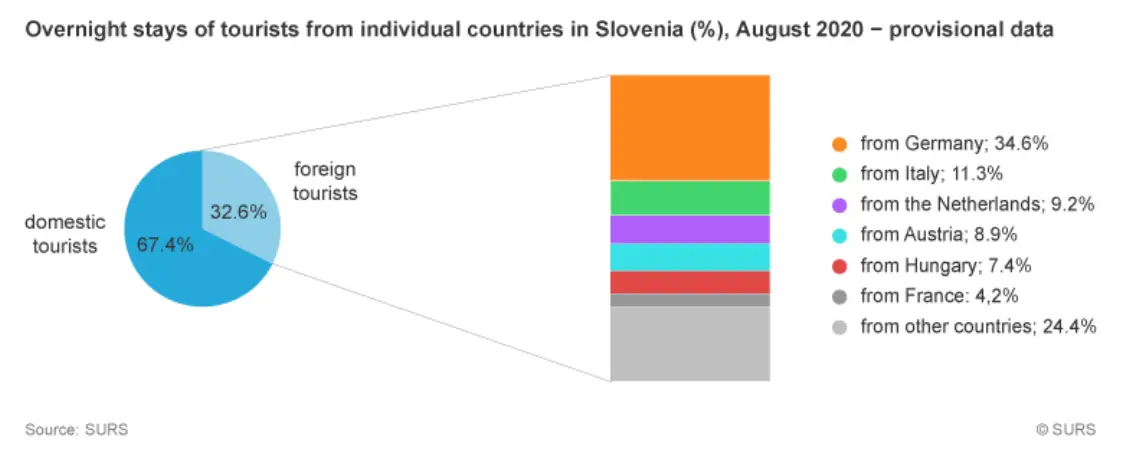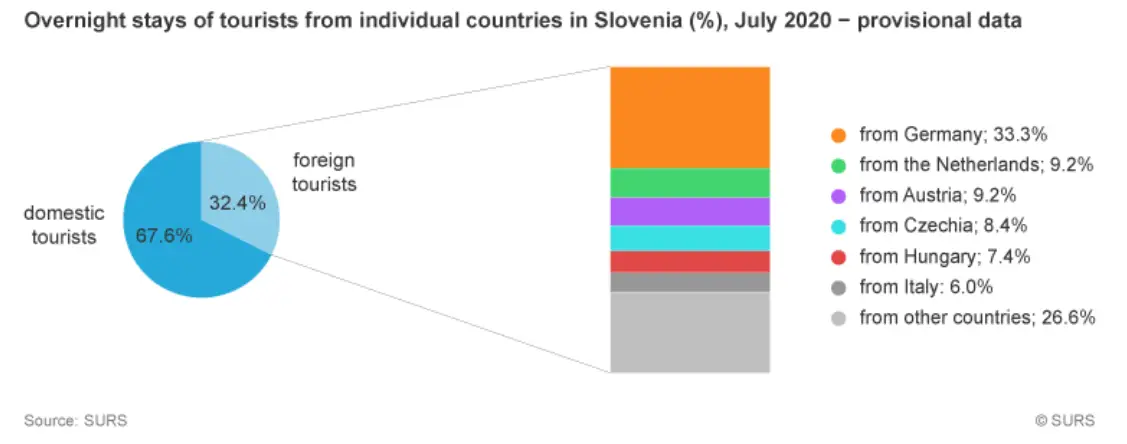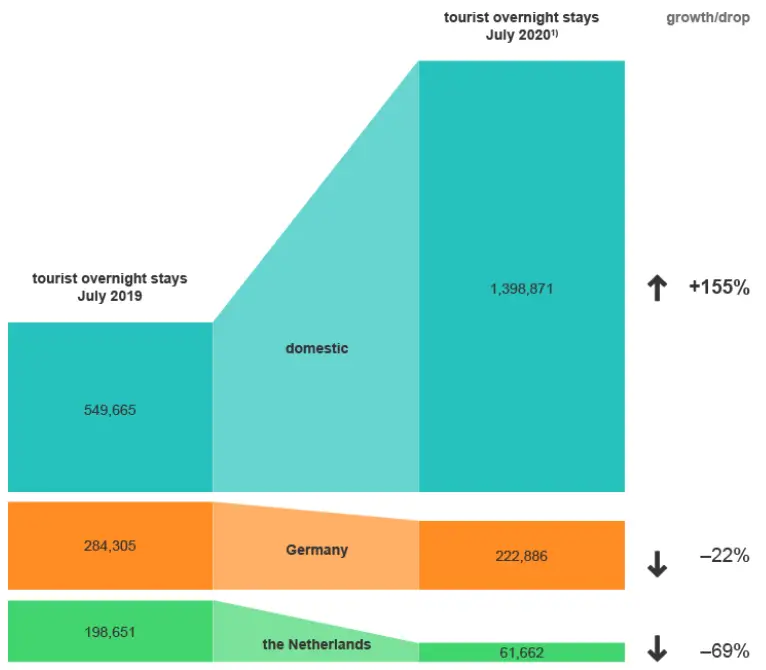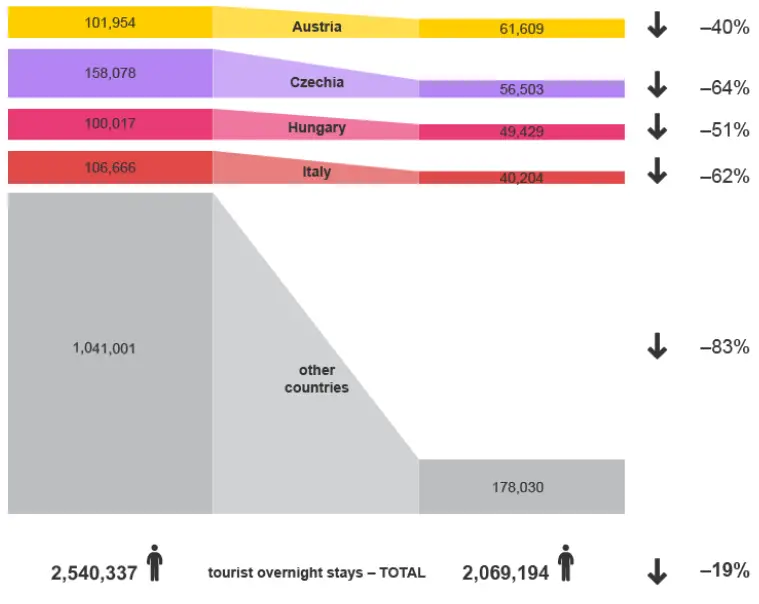Ljubljana related
STA, 5 October 2020 - Slovenia recorded 75 new coronavirus cases from 1,034 tests carried out on Sunday, and another fatality as hospitalisations and intensive care cases climbed further, data from the government show.
The latest figures bring Slovenia's overall tally of cases to 6,573 and the death toll from Covid-19 to 156. There are just over 2,100 active cases, according to tracker site covid-19.sledilnik.org.
The number of patients hospitalised with the novel disease rose by six to 107, with 21 requiring intensive treatment, that is five more than the day before. Eight patients were discharged yesterday.
Government spokesman Jelko Kacin noted that the lower daily case count was due to fewer tests taken, warning that the rate of positive tests remained high, at 7.25% on Sunday after 8.6% the day before.
Moreover, compared to the Sunday a week ago, the number of daily cases rose by 50%, from 50 to 75.
He declared that Tuesday will be the "day of truth". If infections increase further and the trend cannot be contained, "it's very likely we'll have to present certain measures".
He referred to possible measures announced by the government's chief Covid-19 advisor, Bojana Beović, who has talked of a new cap on gatherings and number of people allowed inside shops and bars.
"Her projections are realistic. It's not a measure that would take us days to prepare," said Kacin, suggesting gatherings in private and public places would be limited to ten people flat except when a higher number is sanctioned explicitly by the National Institute of Public Health.
Hospital capacities are becoming stretched due to the rising number of Covid-19 patients, coupled with infections emerging at non-Covid units.
UKC Ljubljana, Slovenia's largest hospital, said today that ten patients and ten staff at the vascular disease unit have tested positive, so they will no longer admit patients there this week.
Meanwhile, one infection has been confirmed in the past days at the UKC Ljubljana's pulmonary disease and allergy unit, where the situation will continue to be monitored.
The UKC Department of Infectious Disease, Slovenia's main Covid-19 treatment facility, is moving non-Covid patients to the Peter Držaj hospital in the Šiška borough, thus freeing up 19 beds at the regular unit and ten intensive care beds for Covid-19 patients.
Coronavirus depresses Ljubljana tourism
STA, 5 October 2020 - Ljubljana, which has become Slovenia's top tourist destination in the past decade, has suffered a significant blow this year, as the coronavirus pandemic suspended air travel. This summer, the capital recorded a total of 160,341 overnight stays, 75% less than last summer.
Director of the Turizem Ljubljana agency Petra Stušek has told the STA that the number of overnight stays in the first eight months of the year reached 425,178, while the number reached 335,132 in August last year alone.
Ljubljana usually draws a great number of foreign tourists, while Slovenians are more likely to stay away. However, this July and August the share of overnights by Slovenians went to 14% from 2.1% in the same period last year. Most overnights were still generated by foreigners: Germans, Italians, Dutch, French and Austrians.
Following the coronavirus lockdown in spring, seven of the city's 44 hotels remained closed due to the drop in visitors, said Stušek, adding that vacancy capacities were down 16% this summer.
Of the 22 hotels included in the agency's basic statistics, 16 are open at the moment, providing 3,873 of the total of 5,022 beds, she added.
"The future depends on a number of factors: epidemiological situation in Slovenia and in our close markets, border regimes, quarantine orders, air traffic and aid from the state," she said.
Meanwhile, the hotels have largely managed to avoid cancellation of conferences planned in Ljubljana this year, with most being postponed to next year, said Stušek.
Even though hybrid events are becoming a trend for scientific and expert events, Stušek believes that in-person events still have a future, as direct personal contact is an important factor.
Stušek also expressed the wish that Slovenia increase the cap on the number of people at gatherings. "Organisers know each participant and are very eager to see participants arrive and leave the event healthy, because this will affect all future events and thus their livelihoods."
Turizem Ljubljana is planning a number of events for this autumn and winter, all in line with the recommendations of the National Institute for Public Health (NIJZ). In November, Gourmet Ljubljana will take place as a series of small events, while December will feature winter holiday events.
Stušek said that the city wanted to see as many events as possible take place, as it tries to attract guests from Slovenia, as well as Italy, Austria, Germany, Croatia, Hungary and Serbia.
STA, 29 September 2020 - More than 820,000 electronic tourist vouchers worth over 113 million euro, which is a third of the total sum available, were partly or fully redeemed by yesterday, fresh data from the Financial Administration (FURS) shows.
The Economy Ministry, which circulated FURS's data, said a recent survey had shown 90% of Slovenian residents intended to spend the vouchers until the end of the year, the deadline to use them.
The poll carried out by Valicon between 18 and 21 September showed that 36% of all permanent residents had already spent their vouchers, whereas 50% still intended to do so. Only 7% of those polled said they would not use their vouchers, the ministry said in a release on Monday.
As many as 57% of those who paid for accommodation and/or breakfast with vouchers were very happy with the service; the average satisfaction mark on the 1-5 scale was 4.4.
As part of the third stimulus package taken amid the Covid-19 pandemic, the government distributed vouchers worth EUR 345 million to help the tourism industry.
An adult permanent resident received EUR 200 and children and youth under 18 EUR 50. First payments with vouchers were possible on 19 June.
STA, 25 September 2020 - The January-August period saw the number of tourist arrivals plummet by 47% to almost 2.4 million, while tourist nights dropped by 40% to almost 7.1 million compared to the same eight-month period in 2019, figures released by the Slovenian Statistics Office (SURS) on Friday show.
The number of domestic tourists rose by 26% in the eight-month period, with nights they generated rising by 34%.
Foreign arrivals plummeted by 70% in this period, and the nights they generated by 67%, SURS data for January-August show.
The drop in foreign tourists was meanwhile partly offset by domestic tourist, who largely opted to spend their summer holidays in Slovenia.
As a result, the summer season - July and August - saw a mere 16% drop in overall tourist nights to 4.6 million compared to last year's summer tourist season.
More than two thirds of all nights in the two months were generated by Slovenian residents, whose tourist nights rose by 159%.
The number of nights generated by foreign tourists in July-August meanwhile plummeted by 65%.
The bulk of nights generated by foreign tourists in the two months were generated by Germans, yet the figure was nevertheless by 22% lower.
Drops in nights by tourists from other countries were even bigger, standing at -67% for the Dutch and for Italians, at -42% for Austrians and -49% for Hungarians.
Drops by nights generated by Australians, South Koreans, Swedes, New Zealanders, Maltese and Israelis were at more than 95%.
Israelis for instance generated around 128,000 nights in the 2019 summer season as opposed to below 600 this year.
At municipality level, the bulk of tourist nights in July and August were spent in the mountains (1.6 million), on the coast (1.2 million) and in spas (929,000).
Compared to last year's summer season, the sharpest fall in tourist nights was witnessed by the city of Ljubljana (-75%), followed by other urban municipalities (-45%).
Municipalities with spas and on the coast meanwhile reported about upbeat tourist night figures - up by 9% and 4%, respectively.
The coastal municipality of Piran led the way with the biggest number of nights among all of Slovenia's 212 municipalities at 686,000, up 1% from July-August in 2019.
The figures for the second quarter meanwhile show that at least 15% of Slovenia's residents aged at least 15 went on a private trip, a drop of two thirds over the same period last year. A third of around 1.5 million residents who did not go on a trip cited the pandemic as the main reason.
This year's April-June quarter saw the same number of private trips as the January-March quarter, yet considerably fewer than the second quarter last year.
The April-June period has been in recent years a busy tourist period with around a million private trips taking place. This year's figure reached only some 410,000.
An increasing number, or 52%, opted to go on a private trip around Slovenia, whereas Croatia topped the list of destinations outside the homeland (92%).
STA, 10 September 2020 - US luxury and lifestyle travel web portal Conde Nast Traveler has picked Slovenia as the top holiday destination for 2021. Tucked between old favourites Italy and Croatia, Slovenia offers Michelin-starred food, excellent wine, turquoise rivers, glacier-fed lakes and soaring, snow-capped peaks, it says on its web site.
The country's most famous landmark, Lake Bled, is described as being "more peaceful than any of Europe's better-known lakes". "For now, at least, it remains blissfully unbusy; a place of wide-open spaces, splendid solace and restoratively pristine air."
Conde Nast Traveler further highlights the country's cuisine and wine, and the Michelin-starred restaurants - Hiša Franko led by chef Ana Roš and the Strelec restaurant at Ljubljana Castle.
Slovenia is followed on the list of best places to visit in 2021 by England's Yorkshire, Portugal's Melides, the United Arab Emirates and Canary Islands.
You can read the full article here
STA, 7 September 2020 - The Kobilarna Lipica stud farm expects this year to see only a third of last year's number of visitors due to the Covid-19 pandemic, according to a business report which also shows that in the first half of the year, its operator recorded only 34% of the revenue from the same period in 2019.
The pandemic has resulted in the cancellation of a large number of planned events, a decline in visits by foreign guests and large organised groups from Slovenia and abroad, and the renovation of Hotel Maestoso, Holding Kobilarna Lipica told the STA on Monday.
However, the drop in revenue does not stand out when compared to the results of other comparable tourist destinations, the company's supervisory board has assessed, while adding that additional measures to cut costs and maximise the income needed to be nevertheless introduced.
Lay-offs are not envisaged for the time being and, considering the tourism trends and the situation related to Covid-19, the current number of employees is appropriate, the management has assessed.
The management has been tasked with coming up with a new marketing campaign, which will include the promotion of Hotel Maestoso, which is expected to reopen at the beginning of 2021 with a doubled number of rooms.
Holding Kobilarna Lipica also said that the medium-term goals also included taking a EUR 5 million bank loan to renovate the swimming pool and wellness complex of the hotel.
According to the latest report on tourist voucher consumption by the Financial Administration (FURS), 25% of all beneficiaries had used their voucher or part of it by August 23, which amounts to 69,797,643 EUR spent, or 19,6% of the entire 356,858,450 EUR sum value. On average people spent 136.43 EUR of the voucher and were on average 38.4 years old.
Furthermore, FURS reports that 55,754 beneficiaries transferred their vouchers to someone else and that the average age of those passing on the money was 64.3 years.
In terms of geography, leading the list of top ten municipalities where most vouchers have been spent is Piran, followed by Kranjska gora and Bohinj.

Distribution of cashed vouchers by region:

Municipalities according to vouchers spent:

Where did people from Ljubljana spend their vouchers?

Where did people from Maribor spend their vouchers?

Where did people from Kranj spend their vouchers?

Where did people from Koper spend their vouchers?:

Where did people from Novo Mesto spend their vouchers?:

Where did visitors to Piran mostly come from?:

Where did visitors to Ljubljana come from?:

People using their vouchers mostly decided to stay in hotels, with the following places most popular in each of the categories:

STA, 25 August 2020 - The Slovenian tourism industry, which has been severely affected by the Covid-19 epidemic, saw an upbeat trend in Slovenian tourist arrivals and nights in July, partly offsetting the low numbers from the first half of the year, show the latest figures released by the Statistics Office on Tuesday.
Over 653,000 arrivals were recorded at accommodation facilities in July, down 27.5% compared to July 2019, with the number of nights down by 18.5% to 2.07 million.
However, the number of Slovenian tourists in the overall number increased by 176% to almost 404,000, and the number of nights they spent there by 155% to nearly 1.4 million.
The number of foreign arrivals meanwhile dropped by 67% to slightly over 249,300, and the number of nights they spent in Slovenia by 66% to over 670,300.
Germans spent the most nights in Slovenia in July, or 33%, followed by the Dutch and Austrians (9% each), Czechs (8%) and Hungarians (7%).
The most popular areas for tourists, domestic and foreign, were mountainous areas, which accounted for 35% of all tourist nights, followed by the coast (29%).
Thirty percent of all nights were made at hotels, 27% at private rooms, self-catering units and houses, and 22% at camping sites.
Although several areas in Slovenia have had a good summer season, Slovenian tourism has been considerably affected by the epidemic, with facilities in full lockdown for several weeks.
The January-to-July period saw almost 1.6 million tourist arrivals, a 54% drop compared to the same seven-month period in 2019. Tourist nights meanwhile dropped by 48% to around 4.6 million.
In the first half of the year, arrivals by Slovenian tourists dropped by 5% but a 2% rise was recorded in nights generated by domestic guests compared to January-July last year. The number of foreign tourists arriving in Slovenia plummeted by 71% and the nights they generated by 68%.
The figures are in line with the Slovenian Tourist Board's projections of a 70% drop in foreign arrivals for the year and of a 50% overall drop because of a rise in domestic tourists.
To help the industry survive, the government introduced a special voucher scheme, giving every permanent resident EUR 200 to spend in Slovenia until the end of the year on bed and breakfast, with minors receiving EUR 50.
Presenting the latest figures about the vouchers, Economy Minister Zdravko Počivalšek said Sunday was a new milestone as over 500,000 vouchers had been redeemed.
"In a good two months since this measure was introduced, a quarter of all vouchers have already been spent, while bookings for another 30,000 have already been made."
Figures from the Financial Administration show that 511,554 vouchers, worth EUR 69.8 million, were redeemed between 19 June and 23 August, whereas the total value of vouchers available is around EUR 357 million.
Počivalšek believes the tourist vouchers have saved the summer season for many tourism companies or helped some survive the epidemic, at the same time enabling many to be able to afford to go on a holiday.
He is also confident that thanks to the vouchers, Slovenians have discovered many corners that have so far been less known and less visited. He hopes the thrill at discovering Slovenia turns into a trend of Slovenians spending at least part of their holidays at home.
Although it is too early to take stock of the summer season, Počivalšek said "we are better off than some comparable countries".
In July and August, tourist numbers at some locations were already on a par with or even better than last year, the only difference being that domestic tourists outnumbered foreign ones, he explained.
He believes these figures could hardly be reached if the epidemiological situation had not been kept under control. He thus urged tourism companies to be innovative in providing for coronavirus safety, so that foreign tourists could soon return in bigger numbers.
As for extending the use of vouchers into the spring of 2021, the minister said efforts were now focussed on encouraging people to use them by the end of the year.
"Should any other measures be needed, I believe we'll take them in time," Počivalšek said at a news conference in Ljubljana.
Over EUR 1 million in vouchers was spent a day in the period between 19 June and 23 August, with the average age of tourists using the vouchers at slightly over 38.
The figures also show over 55,700 people aged an average 64 years transferred their vouchers on family members, meaning many elderly did not go on holiday themselves.
You can see more of this data at SURS
STA, 22 August 2020 - Slovenian tourism will see a 70% drop in tourists from abroad this year, but Slovenians holidaying in the country in big numbers, also due to tourist vouchers distributed by the state to help the industry, will offset the loss somewhat, so that the overall drop is to amount to around 50%.
To accommodate the industry to a new reality resulting from the coronavirus, Slovenian partners are working on a recovery plan, Slovenia's Tourist Board (STO) announced.
The STO is aware people will always want to travel, yet not at all cost, but to "destinations which can guarantee a safe and at the same time pleasant experience", STO director Maja Pak said in a release.
The STO is thus working together with the Economy Ministry, tourism industry representatives, product associations and destination managers to prepare a recovery plan for Slovenian tourism.
The document is to digitalise and optimise marketing and promotion to bring them in line with travellers' new habits, and bring new criteria to assess success in tourism.
Since the coronavirus hit the country in March, the STO has launched several campaigns, focussing on promoting Slovenia as a green, safe and responsible destination.
Just recently, Virtuoso Travel Week, an online event promoting boutique and luxury tourism, was attended by over 4,000 tourist agents and destination managers from 96 countries.
The STO is also enhancing communication with foreign businesses with new projects.
One is a digital platform enabling travel agents to deepen their knowledge about Slovenia and potentially include it among their destinations.
World Travel & Tourism Council (WTTC) data shows interest in travel is still below last year's, but despite a 20% drop in the interest, Europe is still the most desired tourist destination.
STA, 11 August 2020 - Slovenians have used EUR 49.71 million worth of tourism vouchers between 19 June and 9 August, which is 14% of the amount made available as part of the government's stimulus scheme, in place until the end of the year. The coast, mountains and spas have been the primary beneficiaries, while cities are continuing to struggle.
The total value of tourism vouchers available to Slovenia's 2.08 million residents is EUR 356.9 million, with each adult having EUR 200 and each minor EUR 50 at their disposal to pay for accommodation and breakfast in hotels, self-catering units, camps, agritourism farms and other similar facilities.
Data from the Financial Administration show that 17.6% of the vouchers have been fully or partially redeemed so far, with 14% of the total amount available spent.
The coastal municipality of Piran stands out with EUR 9.9 million collected so far, while other coastal areas also benefited greatly - EUR 2.8 million worth of vouchers have been spent in Izola, EUR 1.7 million in Koper and EUR 1.6 million in Ankaran.
Major Alpine resorts have also been doing well. The figure for Kranska Gora is EUR 3.4 million, for Bohinj EUR 2.8 million and Bled EUR 1.7 million. Locations along the Soča river have been popular too, with Bovec for instance getting EUR 1.5 million through vouchers.
Spas have been doing well as well, in particular Moravske Toplice, which has secured EUR 2.7 million worth of payments through vouchers.
The figures are less encouraging for Ljubljana, with the capital recording EUR 397,000 worth of such payments, for Maribor (EUR 296,000), and Postojna with its caves (EUR 128,000).
The Slovenian Hospitality Chamber (TGZS) has highlighted this gap, while also pointing to the major decline seen at gaming destinations, some of which have seen only 10% of their capacities filled.
The vouchers have tilted the scales when it comes to the share of domestic and foreign guests in Slovenian tourism in favour of the former, which accounted for between 70% and 75% in July and August. The total figures are about a third below those seen last summer, the TGZS's Fedja Pobegajlo told the STA.
He noted that along with the discrepancies among individual municipalities, certain tourism sectors, such as agencies, transport companies, gaming companies, restaurants etc. have not benefited directly from the vouchers, as these cannot be used for their services.
According to the TGZS the amounts spent by guests on top of the vouchers have been below expectations, "while we are also surprised by the relatively low share of redeemed vouchers". Pobegajlo said the TGZS believes it would make sense to prolong the validity of the vouchers until next spring and adopted additional measures to help the sector.
More on Slovenia’s tourism vouchers
STA, 2 August 2020 - Growing interest in wine tourism in the south-eastern Dolenjska region among Slovenians, sparked by introduction of holiday vouchers, will help improve the tourist season in the region, Dolenjska tourism providers who base their services on vineyard cottages known as zidanice have said.
The zidanice, regionally well-known simple houses with wine cellars surrounded by rolling hills and vineyards, have been the mainstay of the region's tourism for years, apart from spa resorts.
The increased interest, brought about by the vouchers, the government measure designed to boost Slovenian tourism in the wake of the Covid-19 epidemic, will have a long-term positive effect in terms of promoting these rural retreats.
Petra Štukelj, a representative of the Zidanice Tourism Consortium Association, told the STA that at the beginning of the epidemic, up to 90% of zidanice bookings were cancelled, mostly by foreign tourists, who had accounted for the majority of guests in previous years.
Launching the vouchers has mitigated the situation, with Slovenians opting for discovering their own country amid coronavirus concerns and travel restrictions, she said.
In April, vineyard cottages were virtually empty, whereas in May, the situation started turning for the better. June compared to the same period last year and in July, the occupancy rate increased by as much as some 40% on July 2019.
The providers expect to see the upward trend carry on into the following months.
The share of domestic guests was less than 25% last year, whereas this year it has climbed to 75%. Summer months and September are the busiest, with the zidanice being perfect for smaller groups of visitors.
Apart from Dolenjska, the consortium also provides accommodation services in wine-growing regions of Posavje, Bela Krajina and Obsotelje in south-eastern and eastern Slovenia.
Holidaying zidanice-style comes with wine-tasting and culinary experiences, countryside hospitality, gorgeous views of rural landscape and a plethora of sports activity options, the association said.g








